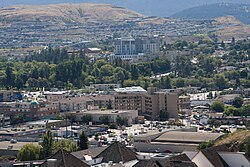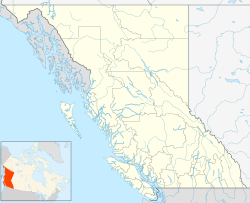
Back فيرنون (كولومبيا البريطانية) Arabic Вернан (Брытанская Калумбія) Byelorussian Vernon (lungsod sa Kanada) CEB Vernon (British Columbia) German Vernon, Kolombiyay Britanya DIQ Βέρνον (Βρετανική Κολομβία) Greek Vernon (Brita Kolumbio) Esperanto Vernon (Columbia Británica) Spanish ورنن، بریتیش کلمبیا Persian Vernon (Brittiläinen Kolumbia) Finnish
Vernon | |
|---|---|
City | |
| The Corporation of the City of Vernon | |
 Downtown Vernon in 2011 | |
|
| |
| Coordinates: 50°16′00″N 119°16′18″W / 50.26667°N 119.27167°W | |
| Country | Canada |
| Province | British Columbia |
| Regional District | North Okanagan |
| Incorporated | 30 December 1892 |
| Government | |
| • Mayor | Victor Cumming |
| • Governing Body | Vernon City Council |
| • MP | Mel Arnold |
| • MLA | Harwinder Sandhu |
| Area | |
• City | 95.76 km2 (36.97 sq mi) |
| • Metro | 1,040.82 km2 (401.86 sq mi) |
| Elevation | 380 m (1,250 ft) |
| Population (2021) | |
• City | 44,519 |
| • Density | 461.7/km2 (1,196/sq mi) |
| • Urban | 51,896 |
| • Metro | 67,086 |
| • Metro density | 64.4/km2 (167/sq mi) |
| Population counts are taken from the 2021 Canadian census.[1] | |
| Time zone | UTC−08:00 (PST) |
| • Summer (DST) | UTC−07:00 (PDT) |
| Forward sortation area | |
| Area code(s) | 250, 778, 236, 672 |
| Highways | |
| Website | vernon |
Vernon is a city in the Okanagan region of the Southern Interior of British Columbia, Canada. It is 440 km (270 mi) northeast of Vancouver. Named after Forbes George Vernon, a former MLA of British Columbia who helped establish the Coldstream Ranch in nearby Coldstream, the City of Vernon was incorporated on 30 December 1892. The City of Vernon has a population of 40,000 (2013), while its metropolitan region, Greater Vernon, had a population of 58,584 as of the 2011 Canadian census.[2] With this population, Vernon is the largest city in the North Okanagan Regional District. A resident of Vernon is called a "Vernonite".
- ^ Government of Canada, Statistics Canada (9 February 2022). "Census Profile, 2021 Census of Population". www12.statcan.gc.ca. Retrieved 25 July 2023.
- ^ "Population and dwelling counts, for Canada, census metropolitan areas, census agglomerations and census subdivisions (municipalities), 2006 and 2001 censuses". Statistics Canada. Archived from the original on 2 October 2009. Retrieved 15 March 2007.


